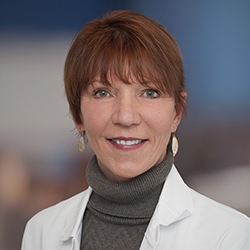Supporters Like You
Read about supporters who give kids hope for today and better futures for tomorrow.
Cole Hardman
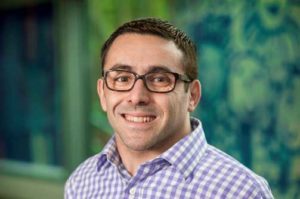 Former-Patient-Turned-Employee Shares What It Means to Survive, Thrive and Live a Full Life
Former-Patient-Turned-Employee Shares What It Means to Survive, Thrive and Live a Full Life
Cole Hardman included Seattle Children’s in his estate plan to ensure patients and families have access to the quality care they deserve. Hardman – a former patient – credits the teams at Seattle Children’s for saving his life and inspiring him to become a professional fundraiser. He is now the Director of Development, Major Gifts for Seattle Children’s Hospital and Research Foundation.
Read more of his story
From the day he was born, Cole has been deeply connected to Seattle Children’s — a connection that has not wavered in the 33 years since his birth.
As a former-patient-turned-employee, Cole (pictured at right) uses his unique perspective and positive spirit to not only raise much-needed funds to support Children’s mission, but to also show patients and families that what may seem impossible can be possible.
“Children’s played an instrumental role in helping me maximize my potential and live a full life,” says Cole, major gifts officer with Seattle Children’s Hospital and Research Foundation. “Working at Children’s is more than a job for me. It’s a labor of love.”
The early years
When Cole was born about five weeks premature, doctors noticed that his face was blue and his oxygen level was very low. He was born with a congenital diaphragmatic hernia — a birth defect that causes the diaphragm to not form completely before birth. The diaphragm is a thin muscle inside the body that separates the chest from the belly. It is the muscle used when a person inhales while breathing.
Patients with congenital diaphragmatic hernias have a hole between their belly and their chest. Organs that should be in the belly instead go through the hole and into the chest. In Cole’s case, his small intestine was located where his left lung should have been.
To address this issue, he underwent a six-hour surgery at Children’s the day he was born to move his small intestine to the proper location so his left lung could develop. At that time, Cole’s family was told that he had a 40% chance of surviving the surgery and, if he did make it through the surgery, he may not survive to the age of 2.
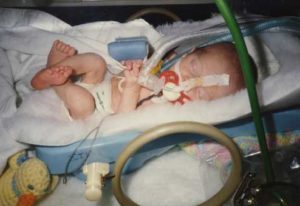
Cole Hardman spent his first few months in the Neonatal Intensive Care Unit at Seattle Children’s fighting for his life
Cole made it through the surgery, but his left lung never fully developed. He functions off one lung, making it challenging to breathe.
After the surgery, Cole spent his first year at Children’s fighting to stay alive.
“It was a very intense and scary time,” recalls Wendy Hardman, Cole’s mom. “Cole was at death’s door many, many times.”
She recalls several calls in the middle of the night from Children’s care team members saying they did not know if he would make it through the night.
He did make it, but not without many other obstacles along the way.
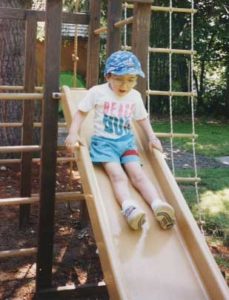 In addition to Cole’s breathing issues, he also has vision and hearing impairments, and a severe case of congenital scoliosis (curvature of the spine). He underwent an experimental surgery as a teenager to straighten his spine, but it was ineffective since it was too late in his development to help correct the problem.
In addition to Cole’s breathing issues, he also has vision and hearing impairments, and a severe case of congenital scoliosis (curvature of the spine). He underwent an experimental surgery as a teenager to straighten his spine, but it was ineffective since it was too late in his development to help correct the problem.
Although his early years were touch and go, Cole credits everyone at Children’s — from scheduling coordinators to nurses to providers — for making sure he received the very best, most compassionate care.
“I found a second home at Children’s,” says Cole. “It was always a positive place. When nurses and doctors spoke to me, I always felt like I was their only patient. I was included in conversations and decision-making as I got older, which was really important and valuable.”
Despite several medical issues, Cole Hardman has learned to adapt and enjoy many of life’s simple pleasures. Pictured above is 4-year-old Cole playing in his backyard.
From grateful patient to grateful employee and donor
Because of Cole’s positive experiences at Children’s, he and his family decided to give back to the organization that had saved his life. The Hardmans began partnering with Seattle Children’s Hospital and Research Foundation in the early 90s to help raise money to support other kids like Cole.
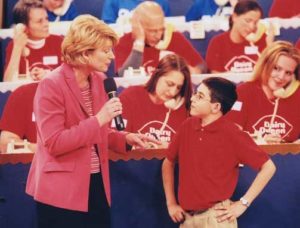 In 1994, 7-year-old Cole was featured during a telethon on KOMO 4 TV — one of many telethons he participated in over the years. He attended and spoke at various fundraising events during his childhood and throughout college, including Festival of Trees and the Auction of Washington Wines.
In 1994, 7-year-old Cole was featured during a telethon on KOMO 4 TV — one of many telethons he participated in over the years. He attended and spoke at various fundraising events during his childhood and throughout college, including Festival of Trees and the Auction of Washington Wines.
This glimpse into fundraising from a young age showed him that there was a professional path he could take to give back to the organization that had such a profound impact on his life.
Since Cole Hardman was 7, he has participated in various fundraising events to support Seattle Children’s. Pictured above, 12-year-old Cole participates in a KOMO 4 TV telethon.
After spending six years with the United Way of King County, Cole joined Children’s foundation in October 2016.
“I always knew that one day I’d end up back at Children’s in a professional capacity,” says Cole. “When I got the job, it felt like I came back home to serve a purpose. This is where I belong.”
In his role, one of his favorite tasks is meeting with patient families and helping identify what they are passionate about and how they can financially support the organization based on those interests. When appropriate, he shares some of his own story with families to spread hope and to let them know they are not alone.
Not only is Cole a talented fundraiser and tireless advocate for patients and families, he also donates to Children’s annually and through his estate plan.
“I have seen the amazing work we do both as a former patient and a current employee,” he says. “I donate to Children’s because I want to help all families have access to the quality care they deserve, and ensure that our organization is well positioned to serve our patients for a very long time.”
—By Jaclyn Houghton Bardin
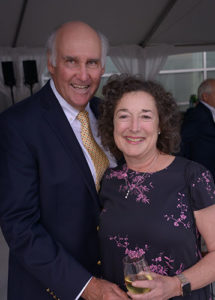
Peggy and John Walton
It goes without saying that everyone needs healthcare regardless of their social or economic standing. Every child in our community represents our future and, to us, few things are more important than good health.
We’ve been supporting Seattle Children’s as guild leaders and through Children’s Circle of Care for more than 20 years. We are continually inspired by the personal impact the Uncompensated Care Fund has on families who receive support.
Read more of their story
We appreciate that it is unique to have a hospital, especially a children’s hospital, designed to make medical advances informed by discoveries in the lab and care delivered at the bedside. With doctors focused on both, we’re seeing advances in areas like cancer research and brain tumors. This work shows how Seattle Children’s is fulfilling its promise to improve care and find cures.
Including Seattle Children’s in our estate plan is our way of continuing our tradition of giving after we’re gone. Some people may think their money doesn’t make a difference, but we have seen through our years of involvement that every dollar matters and every child matters.
Peggy and John Walton are members of the Ned and Kayla Skinner Guild, and John is treasurer of the Swim for Children’s Guild. They are also members of Children’s Circle of Care and the Guardians’ Circle. In 2006, Peggy and John established the Walton Family Endowment, which supports brain tumor research. Peggy has served on both the hospital and foundation boards.
By Peggy and John Walton
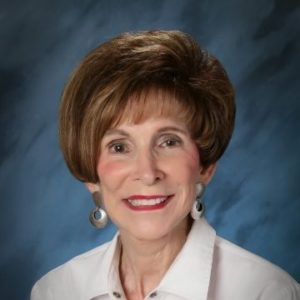 Jan Sayers
Jan Sayers
“When I first visited, I was struck by the hope and love in the Seattle Children’s classroom. Having that normalcy and routine gives kids coping with serious illnesses the opportunity to exercise their minds, make friends, giggle and to be free from their burdens, if only for a few hours a day. I say “YES” because I have always believed that you are not a whole person until you give back to others.”
Read more of her story
Seattle Children’s Hospital Education Program offers a typical childhood and adolescent experience in the midst of a medical journey. For the more than 1,400 kids who come into the Jan Sayers Schoolroom each year, our classroom is one of their most important connections to being a normal kid during their journey. We endeavor to make learning as similar to their regular classroom experience as possible so children are prepared to easily return to their local school when they are ready.
Jan Sayers was an English teacher at Mercer Island High School for 28 years. She is revered as a passionate educator who demonstrated an unwavering desire for her students to grow into people of great character. She is also a tremendous champion of Seattle Children’s and generous supporter of the Education Department.
In 2013, Jan came to us and told us she would like our classroom to be a beneficiary of her and her family’s estate. Because of her incredible commitment, 12 teachers and education support staff now work in the Jan Sayers Schoolroom.
Every day, patients pass by her name as they come into a safe space where they’re able to learn, explore, make friends, be creative and, most importantly, be kids. Jan’s generosity ensures this program will carry forward for the next generation of students. Her enthusiasm for both education and community building encourages and motivates our teaching team.
Jan’s passion for Seattle Children’s grew from her personal experience supporting several of her students as they journeyed through complex medical crises while in high school. She saw how critical it was for patients to still be students and sees our educational program as a way to support positive physical and emotional health outcomes. Jan has been advocating for us ever since.
By Scott Hampton, manager, Seattle Children’s Education Department
Kathy and Richard Miyauchi
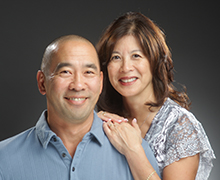 “It meant a lot to Michael when he saw people share their time and give with their hearts,” Kathy says of her son’s experience at Seattle Children’s. “That’s how you make the lives of others better.”
“It meant a lot to Michael when he saw people share their time and give with their hearts,” Kathy says of her son’s experience at Seattle Children’s. “That’s how you make the lives of others better.”
Read more of their story
Kathy and Richard Miyauchi would prefer to inspire generosity in others rather than be recognized for their own philanthropy. They lost their son Michael to non-Hodgkin’s lymphoma when he was 20 years old. Michael believed that his mission in life was to help others and to lift the spirts of those he met. After his diagnosis, his compassion only grew.
Michael underwent many rounds of chemotherapy and radiation during his cancer treatment. In that time, he spent hours talking to his family about his beliefs. Kathy and Richard remember him saying, “It’s easy to write a check, but it’s also important to give your time.” Inspired by Michael’s call to action, the Miyauchis started a charity golf tournament a few months after his passing to benefit cancer research and treatments.
The couple also made a bequest in their will to support cancer research at Seattle Children’s Research Institut. They have established the Michael Miyauchi Endowment for Cancer Research at Seattle Children’s. “Children’s combines two of our passions: fighting cancer and helping kids,” they say. Establishing an endowment in Michael’s memory and making Seattle Children’s one of the beneficiaries in their estate plan was “a natural thing.”
“Michael put the spark into all of us to be compassionate and generous,” says Kathy. “The 20 years we had with him is and was a wonderful gift, a gift that keeps on giving to us and so many others.”
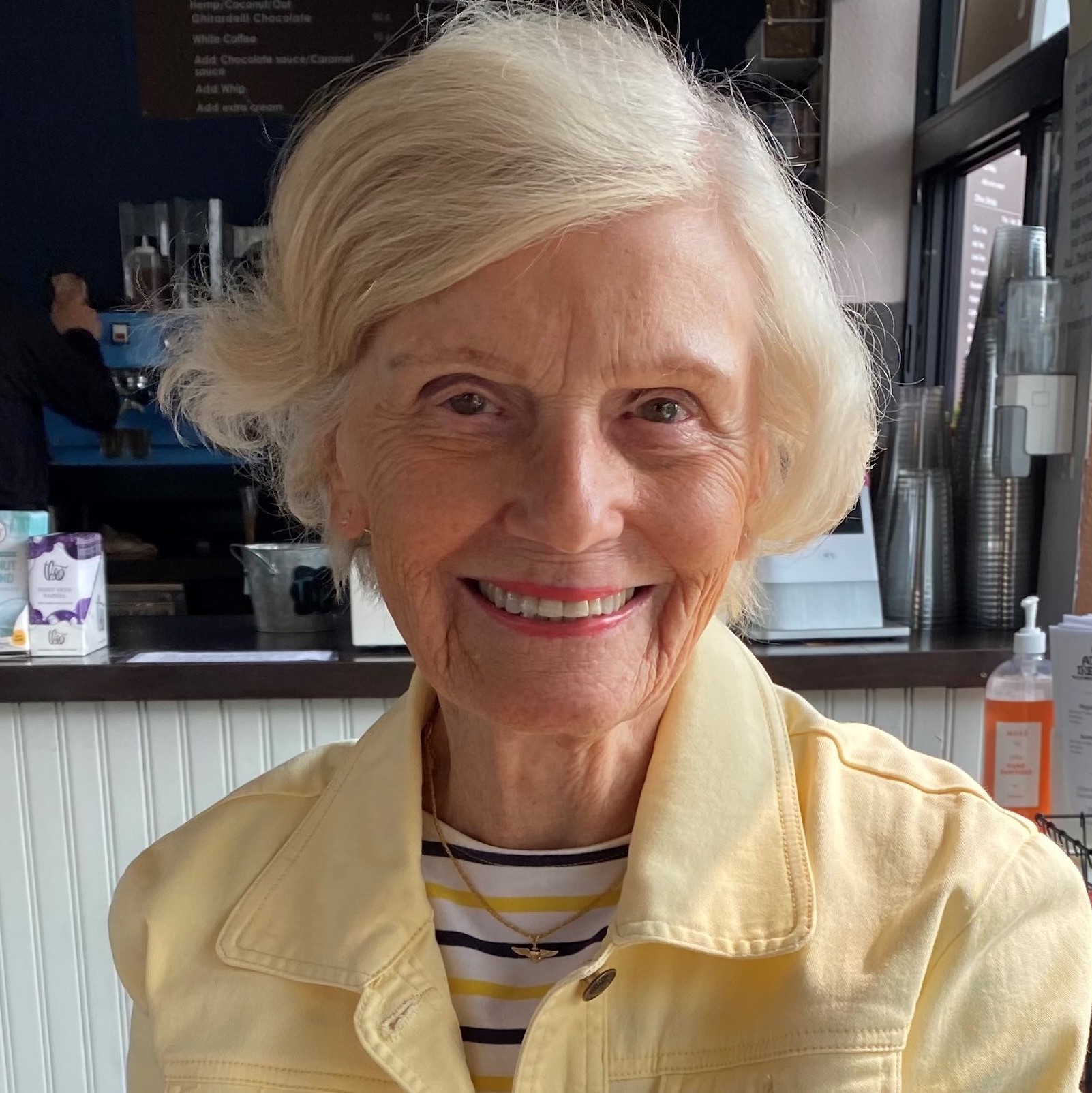 Mary Breivik
Mary Breivik
Seattle native Mary Breivik has been inspired for many years by the good work performed by Seattle Children’s Hospital for patients and families. The appreciation was amplified when her oldest son, at age seven, needed a tonsillectomy and was taken to Seattle Children’s for surgery. It was then that Mary experienced the compassionate care of Children’s first hand.
Read more of her story
Mary and her late husband, Herb, were married for sixty-three years. They spent most of their time in the Seattle area where Herb was based as a United Airlines Captain. They raised three children and were blessed with six grandchildren as well. Mary and Herb enjoyed many years of retirement together before Herb passed away in 2016.
Giving was important to both of them, and Mary recalls Herb’s joy when donating to charity. That’s why when Mary revised her estate plan recently, she knew he would be proud of her decision to make a charitable bequest of IRA assets to Seattle Children’s and several other charities. “I’m happy to be in a position to help kids. It’s heartbreaking to know that so many children need the services of Seattle Children’s, but this is something I can do.”
Mary is also pleased that she has been able to make donations in recent years through qualified charitable distributions from her IRA, which is a tax-wise way to make a charitable gift. When asked what she would say to others considering a gift to Children’s, Mary says, “It’s such an outstanding hospital, especially if families can’t afford care because Children’s will always care for them. Also, making memorial gifts in honor of friends and family is a meaningful way to make a difference.”
“I’m happy to be in a position to help kids. It’s heartbreaking to know that so many children need the services of Seattle Children’s, but this is something I can do.”
—Mary Breivik
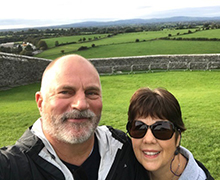 Jim and Melody Carney
Jim and Melody Carney
Jim Carney has been a longtime supporter of Seattle Children’s, and he became more deeply involved in 2006 when he joined the Legacy Council, a group of estate and financial planning professionals who provide advice on charitable planning and outreach efforts to further the mission of Seattle Children’s.
Jim and his wife, Melody, were inspired to help even further when the 12-year old daughter of Jim’s colleague got very sick with liver disease and ultimately passed away. Jim says, “I saw how the hospital allowed him to spend as much time as possible with her. I can’t imagine what a parent goes through when losing a child.”
Read more of their story
Feeling grateful for two healthy kids of their own, the Carneys decided they wanted to help Seattle Children’s continue its mission to provide hope, care and cures for sick kids. Jim, a retired wealth manager, was familiar with Charitable Lead Trusts and thought the option made a lot of sense for them.
Jim and Melody wanted to support the hospital, but they also wanted to be tax-smart about their donation. After consulting with their own advisors, they funded the gift with cash proceeds from the sale of a property. A Charitable Lead Trust ended up being a great way to offset the resulting tax burden while also maintaining long-term control over the assets in the trust. Jim said, “For families like us, who are still saving for retirement, this may be a good option.”
Jim and Melody wanted to make a meaningful contribution to the current campaign for Seattle Children’s, and they hope to pave the way for others who are contemplating making a gift using the simple Charitable Lead Trust structure that they did. “Having an overall plan gives you the sense of security in your own financial world, which, in turn, allows you to help others with more confidence and in a personally meaningful way,” Jim says.
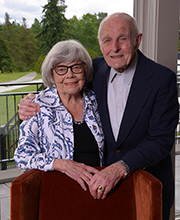 Dick and Faye Gillett
Dick and Faye Gillett
While Faye and Dick Gillett do not have any family members who have been treated at Seattle Children’s, the Bellevue residents are longtime supporters of the hospital. “I started as a monthly supporter because I knew the important role Seattle Children’s played in our area,” Dick says.
Read more of their story
Dick grew up in Chicago and spent 33 years in the U.S. Coast Guard. His wife, Faye, retired in 2000 after a career as a nurse in Southern California. The couple married in 2003 after Dick lost his first wife to a 12-year battle with cancer. “After a couple of years of giving, I was invited to take a tour of the hospital and was motivated to give more to help in the drive for campus expansion,” Dick says. “I created my first charitable gift annuity in 2011 to support the greatest needs of the hospital.”
The Gilletts recently set up their second charitable gift annuity with Seattle Children’s. “We were pleased with the first one and were contemplating a second when we heard a presentation at the 2018 Guardians’ Circle Luncheon from Dr. Ben Danielson, clinic chief and senior medical director at Seattle Children’s Odessa Brown Children’s Clinic (OBCC),” Dick says. “We were inspired by his work and the desire to expand the clinic, so we decided to do a second charitable gift annuity to benefit OBCC.”
Faye and Dick encourage others to consider what legacy they could leave at Seattle Children’s. “Take a tour of the hospital, get involved and learn more about what is happening — it is a wonderful program,” Dick says. “Reading stories about the kids can be heartbreaking, but it is wonderful that we can support these kids and their families.”
“Reading stories about the kids can be heartbreaking, but it is wonderful that we can support these kids and their families.”
—Dick Gillett
Dr. Ruth McDonald
Dr. Ruth McDonald, a vice president and associate chief medical officer at Seattle Children’s, shares her story of why she decided to include the organization in her will. She expresses her appreciation for the commitment to providing exceptional care to every patient regardless of their insurance or ability to pay, something that is made possible thanks to supporters like you. Dr. McDonald is thankful for the opportunity to help kids who need it most and hopes her support for Seattle Children’s will live on even after she has gone.
Read more of her story
Dr. Ruth McDonald, vice president and associate chief medical officer; chief medical operations officer
“I watched our team’s amazing response – and decided to include the organization I’ve dedicated my career to in my will.” – Dr. Ruth McDonald
In 2020, I had a stark realization: As COVID-19 cases exploded, I realized I could die from the virus. I watched our team’s amazing response – and decided to include the organization I’ve dedicated my career to in my will.
It’s a way to give back to an organization that gives me the opportunity to help kids who need it most. I did my residency and fellowship at Seattle Children’s, and was ecstatic when I was able to stay on the nephrology and transplant teams.
I’ve had incredible mentors at every step of the way, who showed me how to always put patients first. I’ve also collaborated with and visited other top pediatric hospitals, which helped me see how unique Seattle Children’s is.
One of the things that has stood out most is our commitment to helping every child who comes through our doors. I’m so grateful to be part of an organization that is striving to find new, better ways to care for every patient in our diverse population.
It’s a huge relief to know that I never have to wonder what insurance a patient has or whether their family can afford certain treatments. Every family I see gets the same exceptional care, no matter what.
This is rare and is only possible because of donors like you. Thank you for your amazing commitment to helping children in every way you can. It’s an honor to work alongside you, and it’s comforting to know that my support for our work and our mission will live on, even when I’m gone.
Join our Guardians’ Circle
Together we can do so much. Join a community of people who share your passion for caring for children by becoming a member of our legacy society.

